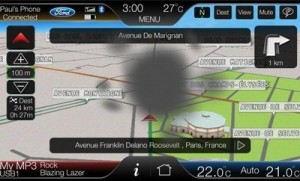
We’ve celebrated Ford’s past during their 2011 UK centenary, and now we’re looking to their future.
Ford have teamed up with Cambridge University to develop and design vehicles for the growing number of visually impaired people.
According to the World Health Organisation there are 285 people with a visual impairment globally, and 65% of these people are over 50.
With our rapidly ageing population, this means that there is likely to be a huge upswing in the number of people experiencing problems with their sight.
Even with such severe conditions as age-related macular degeneration (AMD), glaucoma and cataracts, the conditions can come on so gradually, and the brain is so adept at adapting to the situation, that the condition is often advanced before it seriously impacts driving.
Normal ageing processes affect vision too, as people lose the ability to see fine details and to see in the dark. This can make it hard to take in information from the instrument cluster.
So what are Ford doing about this?
Ford’s collaboration with Cambridge University has culminated in the Vision Impairment Stimulator.
This piece of cutting-edge technology allows Ford engineers and designers to get a much better understanding of how different visual impairments affect drivers.
Ford’s development team can load in an image, select a visual impairment and its severity level, and then experience the image as a person with that impairment would.
This allows engineers to compare how design elements work across the spectrum of visual impairments, and see how tweaking them improves usability for people with AMD, cataracts, colour blindness or glaucoma.
Already benefiting Ford design
At the moment Ford are focusing on the readability of their instrument clusters, and feedback from the stimulator is enabling them to change their design to make them more inclusive.
Veronika Engel, an ergonomics expert at Ford, gives an example of improving design for people with red-green colour blindness. Using the stimulator makes it possible to instantly see if some letters and numbers become hard to read, and to adapt and retest the design accordingly.
Part of Ford’s commitment to inclusive design
Engel points out that many people with visual impairments are still fit to drive, and says that Ford’s work with Cambridge University is part of their commitment to make driving safe and easy for everyone.
As well as this collaboration, since 1994 Ford have invested considerable amounts of time and money in inclusive design.
Engineers at Ford can use a ‘Third Age Suit’, which even comes with goggles stimulating cataracts, to understand the needs of older drivers. The suit restricts mobility and gives a reduced sense of touch.
Ford is expecting that the information gathered from using the Cambridge stimulator will enable them to make future vehicles more accessible to those with visual impairments.
Keep yourself updated with the latest motoring news by liking us on facebook, following us on twitter or connecting with us on LinkedIn.
If you’re interested in purchasing or leasing a new Ford contact our sales team. Alternatively, visit our website where you will find new and used Ford’s available for sale or on finance.
Thanks for visiting us today.
